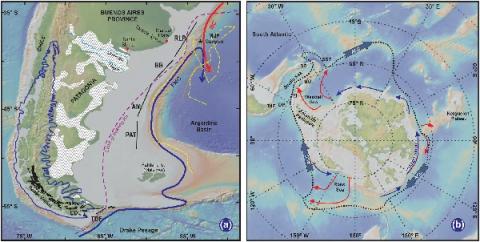G. Bozzano, M. E. Cerredo, M. Remesal, L. Steinmann, T. J. J. Hanebuth, T. Schwenk, M. Baqués, D. Hebbeln, D. Spoltore, O. Silvestri, R. D. Acevedo,V. Spiess,R. A. Violante, S. Kasten,
2 020
Geochemistry, Geophysics, Geosystems, Volume22, Issue1 January 2021
A variety of gravel- to cobble-sized rocks, recovered from the Mar del Plata (MdP) Canyon area (Western South Atlantic at 38°S) and interpreted as ice-rafted debris, represent the first evidence that large icebergs have floated in the Falkland (Malvinas) Current from the southern polar high latitudes far northward. Detailed petrographic analyses identified the Antarctic Peninsula, sub-Antarctic islands in the Scotia Sea, and Tierra del Fuego as plausible source areas. The drift process could have started as early as at the beginning of the last deglaciation, according to an age obtained from a cold-water coral fragment associated with one of the dropstones. At the end of the Last Glacial Maximum, large icebergs have been supplied to the Antarctic Circumpolar Current, captured by those ocean current branches that circumvent the Falkland (Malvinas) Islands and entered the Argentine Margin. When the iceberg fleets approached the Brazil-Falkland (Malvinas) Confluence Zone with its steep latitudinal temperature gradient, the icebergs got oceanographically trapped and melted off rapidly. The sediment load sinking down to the seafloor formed a dropstone blanket particularly where the MdP Canyon had incised into the continental slope. Here, mass-flow processes, induced by local slope instability, and along-slope sediment resorting, due to the erosional effects of strong and persistent contouritic bottom currents, favored local enrichment in dropstones in the form of a loose, coarse sediment drape inside morphological depressions. The bottom current velocity would be locally strong enough to rework this sediment, leaving coarse rafted debris as a lag deposit.
https://doi.org/10.1029/2020GC009333

